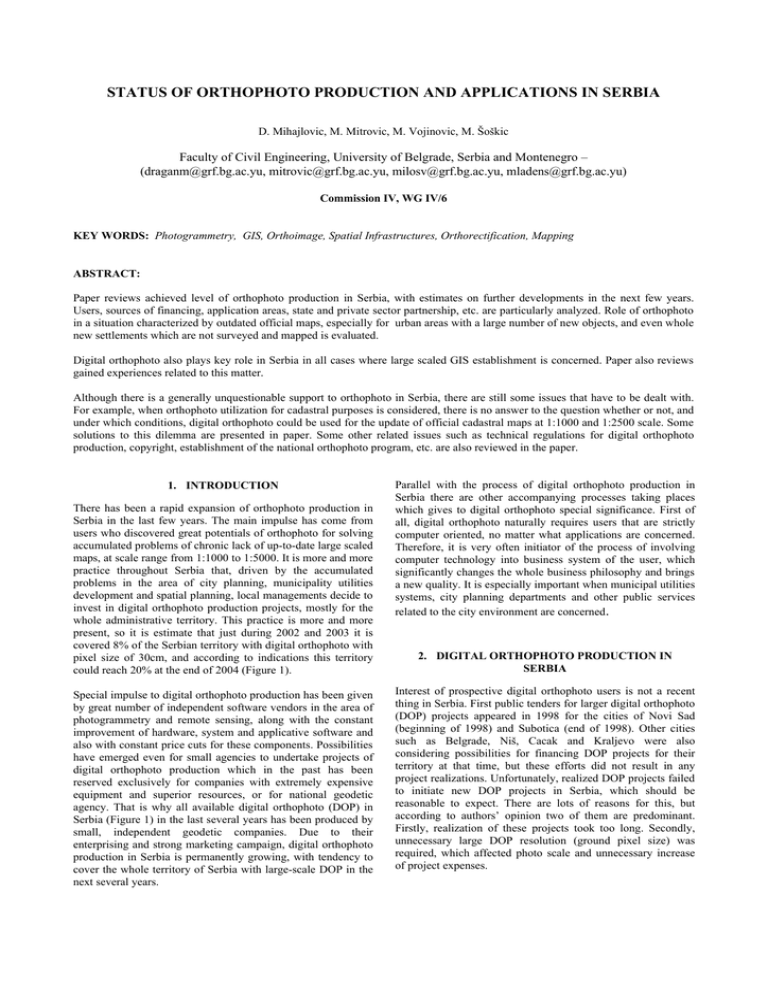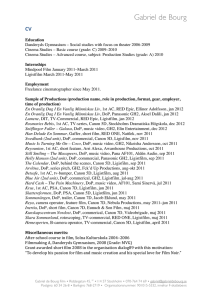STATUS OF ORTHOPHOTO PRODUCTION AND APPLICATIONS IN SERBIA
advertisement

STATUS OF ORTHOPHOTO PRODUCTION AND APPLICATIONS IN SERBIA D. Mihajlovic, M. Mitrovic, M. Vojinovic, M. Šoškic Faculty of Civil Engineering, University of Belgrade, Serbia and Montenegro – (draganm@grf.bg.ac.yu, mitrovic@grf.bg.ac.yu, milosv@grf.bg.ac.yu, mladens@grf.bg.ac.yu) Commission IV, WG IV/6 KEY WORDS: Photogrammetry, GIS, Orthoimage, Spatial Infrastructures, Orthorectification, Mapping ABSTRACT: Paper reviews achieved level of orthophoto production in Serbia, with estimates on further developments in the next few years. Users, sources of financing, application areas, state and private sector partnership, etc. are particularly analyzed. Role of orthophoto in a situation characterized by outdated official maps, especially for urban areas with a large number of new objects, and even whole new settlements which are not surveyed and mapped is evaluated. Digital orthophoto also plays key role in Serbia in all cases where large scaled GIS establishment is concerned. Paper also reviews gained experiences related to this matter. Although there is a generally unquestionable support to orthophoto in Serbia, there are still some issues that have to be dealt with. For example, when orthophoto utilization for cadastral purposes is considered, there is no answer to the question whether or not, and under which conditions, digital orthophoto could be used for the update of official cadastral maps at 1:1000 and 1:2500 scale. Some solutions to this dilemma are presented in paper. Some other related issues such as technical regulations for digital orthophoto production, copyright, establishment of the national orthophoto program, etc. are also reviewed in the paper. 1. INTRODUCTION There has been a rapid expansion of orthophoto production in Serbia in the last few years. The main impulse has come from users who discovered great potentials of orthophoto for solving accumulated problems of chronic lack of up-to-date large scaled maps, at scale range from 1:1000 to 1:5000. It is more and more practice throughout Serbia that, driven by the accumulated problems in the area of city planning, municipality utilities development and spatial planning, local managements decide to invest in digital orthophoto production projects, mostly for the whole administrative territory. This practice is more and more present, so it is estimate that just during 2002 and 2003 it is covered 8% of the Serbian territory with digital orthophoto with pixel size of 30cm, and according to indications this territory could reach 20% at the end of 2004 (Figure 1). Special impulse to digital orthophoto production has been given by great number of independent software vendors in the area of photogrammetry and remote sensing, along with the constant improvement of hardware, system and applicative software and also with constant price cuts for these components. Possibilities have emerged even for small agencies to undertake projects of digital orthophoto production which in the past has been reserved exclusively for companies with extremely expensive equipment and superior resources, or for national geodetic agency. That is why all available digital orthophoto (DOP) in Serbia (Figure 1) in the last several years has been produced by small, independent geodetic companies. Due to their enterprising and strong marketing campaign, digital orthophoto production in Serbia is permanently growing, with tendency to cover the whole territory of Serbia with large-scale DOP in the next several years. Parallel with the process of digital orthophoto production in Serbia there are other accompanying processes taking places which gives to digital orthophoto special significance. First of all, digital orthophoto naturally requires users that are strictly computer oriented, no matter what applications are concerned. Therefore, it is very often initiator of the process of involving computer technology into business system of the user, which significantly changes the whole business philosophy and brings a new quality. It is especially important when municipal utilities systems, city planning departments and other public services related to the city environment are concerned. 2. DIGITAL ORTHOPHOTO PRODUCTION IN SERBIA Interest of prospective digital orthophoto users is not a recent thing in Serbia. First public tenders for larger digital orthophoto (DOP) projects appeared in 1998 for the cities of Novi Sad (beginning of 1998) and Subotica (end of 1998). Other cities such as Belgrade, Niš, Cacak and Kraljevo were also considering possibilities for financing DOP projects for their territory at that time, but these efforts did not result in any project realizations. Unfortunately, realized DOP projects failed to initiate new DOP projects in Serbia, which should be reasonable to expect. There are lots of reasons for this, but according to authors’ opinion two of them are predominant. Firstly, realization of these projects took too long. Secondly, unnecessary large DOP resolution (ground pixel size) was required, which affected photo scale and unnecessary increase of project expenses. Pixel Total size Area [m] [km2] Maps Photos Project Year Techn. Photo scale Beograd 2003 color 1:14500 0.3 3159 468 1100 Lazarevac 2002 graysc. 1:20000 0.3 486 72 101 Lajkovac 2002 graysc. 1:20000 0.3 280 42 60 Požarevac 2002 graysc. 1:20000 0.3 160 25 46 Arandelovac 2003 color 1:17500 0.3 60 13 20 Loznica 2002 graysc. 1:14500 0.3 640 95 292 Pancevo 2002 graysc. 1:14500 0.3 900 132 337 Smederevo 2003 color 1:14500 0.3 500 83 180 Vrnjacka B. 2003 color 1:14500 0.3 300 51 110 Kragujevac 2002 graysc. 1:15000 0.3 125 24 92 0.3 25 7 173 2003 color 1:14500 0.3 27 4 10 1016 2521 Cajetina Kovin 2003 graysc. 1:5000 Total: 6662 Table 2: Overview of existing DOP project 2.2 Digital orthophoto production process Figure 1: Overview of DOP in Serbia 2.1 Chronology 2001 is a year of a significant change. This is initiated by the decision of the Belgrade city management to finance DOP production for approximately 1.000km2 of the Belgrade territory with pixel size of 30cm. The objective was to use DOP as a basis for making master map of the Belgrade. This project was finished for 90 days form the day when aerial photography was made. The success of further activities related to master map was greatly depending on the strict adherence to required DOP quality and project time schedule. Fortunately, the Belgrade master map was at the centre of public attention at that time, so the publicity was in the chance to directly discover the effects of DOP application in the area of town planning. Due to that, already next year (2002) DOP projects of following cities and municipalities started up (Table 2): Lazarevac, Lajkovac, Loznica, Požarevac, Pancevo and Kragujevac. This trend continued in the year 2003 when DOP for the whole territory of Belgrade was made up, as well as the territory of Smederevo and Vrnjacka Banja municipality. All of these projects have very similar technical characteristic (photo scale 1:145001:20000, resolution 0.3mx0.3m, grayscale or color). The proof that these projects are not just accidents is proved by the fact that interest in DOP remained in the year 2004, where several big DOP projects wait to be carried out (for instance, Valjevo, Novi Pazar and Šabac). The interest of some other municipalities is also important and tremendous (Figure 1, Table 4). If this trend remains in the next several years, Serbia will be 100 % covered by DOP in adequate resolution. Prevailing DOP production process in Serbia is still based on standard aerial photogrammetry procedure. All projects (showed in Figure 1 and Tables 2, 4) are realized or will be realized in the same way. START ↓ Image capturing ↓ Scanning ↓ Ground Control Point (GCP) ↓ Aerotriangulation (AT) ↓ Digital Elevation Model (DEM) ↓ Orthorectification ↓ Mosaicking ↓ END Figure 3: Standard procedure of DOP production based on aerial photogrammetry Standard production procedure assumes simple production line shown at Figure 3, which starts with image capturing and ends with mosaicking of DOP. GCPs are provided after image capturing using striking artificial object, clearly visible both on images and the ground. All points are of the same rank, distributed in raster (interval cca 2 stereo basis). Digital terrain model is provided by measurements on digital photogrammetric systems, using original material. In parallel to intensive application of standard DOP production process, some alternative processes are tested, based on highresolution satellite imagery: IKONOS (http://www.spaceimaging.com) and QuickBird (http://www.digitalglobe.com). Except for several examples (DOP of smaller territories) alternative procedure still didn't find wider application in practice (Mihajlovic, et al., 2004). The most important reasons are: • problems of multi user licensing, • cloud coverage, • still insufficient resolution, • gravitation of local companies towards maximal exploitation of already exiting photogrammetric capacities and • still undeveloped market of satellite products in Serbia. Having in mind permanent and evident advance in satellite technology, with continuous cost reduction and performance uplifting, it is to expect that high resolution images will become equal information source for digital orthophoto production in Serbia. 2.3 Dilemma regarding resolution As one can see from the given tables (Table 2, 4), prevailing resolution for the up to know made or planned DOP in Serbia is 0.3m x 0.3m. Although there are examples where coarser resolution was applied, according to our opinion, this resolution is the result of the best possible relation between the price and possibilities. Namely, in the all mentioned cases motives for the starting up the projects were in the domain of town planning, more precisely because existing cadastral maps are very non-upto-date. The main task of DOP pertained the information collection about the space, in particular objects for which the stated resolution was quite enough. There was no dilemma for the most of users that DOP can not be the substitution for largescale maps. This is mostly due to the fact that objects are the weakest point of DOP, because of deformation and “dead angles”. This problem can not be solved by enlarging pixel size. As the price of DOP production rise in geometrical progression with the higher pixel resolution, it is very often the case that pixel size is determined according to available budget. That is why in the most of the projects (showed in Table 4) two resolutions are predicted. For the urban areas predicted resolution is 0.3m and for suburban 0.5m. 2.4 Financial problems Regardless to the fact that knowledge about needs for up-todate cadastral maps are present in almost every local government, the process of decision making for starting up the project is very slow and long. The most important are problems concerning finance. There is confusion in many local areas pertaining state and local authority about this subject. Sometimes, just a motion of good will from some State authority in the sense of symbolic financial support, is enough for local government to make a decision. Additional problem is that persons in charge for making a decision are very often not competent in the area of interest. Project Status Techn. Photo scale 1:14500 1:26000 1:14500 Šabac Planed color 1:20000 1:14500 Kikinda Started color 1:26000 1:14500 Novi Pazar Started color 1:26000 Valjevo Started color Novi Sad Planed Cacak Srem district Vranje district Niš color 1:14500 0.3 891 132 297 1:14500 1:26000 1:14500 color 1:26000 1:14500 color 1:26000 189 28 446 66 1458 216 1188 176 574 85 1924 285 63 53 486 140 192 230 641 215 Started color Planed Planed Planed Pixel Total size Area [m] [km2] Maps Photos 0.3 661 98 233 0.5 480 71 69 0.3 567 84 189 0.5 297 44 55 0.3 81 12 27 0.5 580 115 86 0.3 60 9 21 0.5 716 106 83 0.3 0.5 0.3 0.5 0.3 0.5 color 1:14500 0.3 Total: 1:14500 0.3 1:26000 0.5 95 5122 759 1723 5631 863 716 Total: 10753 1622 2439 Table 4: Overview of projects in preparation for year 2004 New tendencies show that big systems, like electricity distribution companies, communication companies and police are aware and in that sense they show the interest not just to buy final product, but to participate in the process of pre-financing, together with the local governments. It gives additional impulse for easier project financing and for sure simplify the decision making process in those areas where the finances are the prevailing problem. Nevertheless, in those areas where awareness about having DOP is still not so good, even the offer for financial support is not enough for project starting. 3. MULTIPURPOSE ASPECTS OF DOP APPLICATION Although initiative for DOP production in the most cases originate from town planning services of local governments, it should be pointed out that this is the clear case of multipurpose digital maps. Agglomerated problems in the space organizing inflicted DOP not just to town planners, but to the commissions in the process of unlicensed construction legalization. The next group of users is public services – water and electricity supply, Telecom, etc. There’s no general rule, due to the different organization, equipment status of every public service. Although the time of DOP exploitation is very short, some other user groups can be seen coming from the second line. Those are the users which financial capacity and needs are not such to seriously participate in the process of DOP production, but with no doubt about needs to have it. Some of them are satisfied with the coarse DOP resolution, with the price appropriate to the available possibilities. Some of them want micro-locations usually corridors of elongated objects (roads, railways, rivers, etc). Multipurpose aspects of DOP opened some ethics questions to non-profit institutions like museums, research centers, faculties, schools, etc. 4.1 Copyright Copyright of existing DOP are still fuzzy. Namely, DOP is the first cartographic background which is produced in Serbia without any help or support from the state. It is about one quite spontaneous process in local areas as answer to the long termed passivity of in charged state authorities. The only legal act for the DOP production in Serbia at this moment rely in the Law on planning and construction, which treats the DOP as the background for the Master plan production, as well as the regulation for the geodetic works in this area. Sometimes, local governments are financing DOP production, so they consider themselves as the owners of the copyright under DOP. Additional problem arises in the situation when there are more financiers. Practice shows that they are satisfied with the right to make free copies for their needs, while the unlimited copyright remains with the first and biggest investor – local government. Holding the copyrights in very rigid way leads to nothing, when we are talking about industry subjects and citizens. Establishment of the DOP distribution at non-profit principle is in progress. This means that the prices of services for the users are such that they cover just the expenses of ordered material. In this way, DOP becomes public good and local government provides their citizens with public service. 5. INSTITUTIONAL ASPECT Figure 5: Printed form of digital orthophoto 3.1 Problems in utilization The main drawback in DOP utilization is insufficient computer capacities of authorities at local level. Those areas which didn’t accept computer philosophy are natural drawback to the all innovations connected with computer technology. Computer philosophy adopting process is full of sideways. Some cases show that DOP is not in use in digital, but just in analogue, printed form (Figure 5), because that delays facing with the problem. All previous observations on DOP production and utilization in Serbia show complete absence of national geodetic and cartographic institutions, in the sense of production, as well as in planned approach and regulations. In spite of that, willingness of local governments, together with market initiative, showed enviably vitality. What remains is the sad fact that the state didn’t recognize the need to make DOP available to all potential users under the same conditions as the part of national infrastructure of spatial data, as it is the case for some other countries (TeSelle, 1995; Johansson, 1995). Nevertheless, even worst is the fact that national geodetic organization, like Governmental Geodetic Authority and Military Institute, didn’t planned so far digital orthophoto projects within their basic activities. 5.1 Digital orthophoto and real estate cadastre 4. DATA DISTRIBUTION First DOP opened the question of finding the optimal way for its distribution. Namely, it became clear that town planning agencies are disinterested or non-sufficiently qualified to make DOP available to the other potential customers. There are cases that, due to the fear of unauthorized copyrights, DOP remains in the drawers and remains unavailable to other prospective users. After initial problems, the solution is easily coming out. Companies which possess DOP, started to realize their interest to help the local governments. It is to expect very soon the possibility to distribute data through the Internet. This way of distribution is dedicated to the small potential users and citizens. Their goal is multiple: rising general information culture of citizens and organization; contemporary space navigation, promotion of DOP as basic GIS background. Planned services and favors are: overview, space searching, ordering of paper copies, ordering of posters of attractive locations, ordering digital copies of wanted location, ordering of DTM products, etc. In spite of huge efforts to establish real estate cadastre in Serbia, digital orthophoto still didn’t find its place in cadastral application. Still it is fuzzy how and under what condition DOP can be utilized in the real estate cadastre. The answer to the question “Is it possible and under what condition to use DOP in order to up-to-date cadastral maps in the scale 1:1000 and 1:2500?” should be given. This is necessary, because in this moment extent of this work cannot be clarified. It means that classical way of field works may just slow down the process of legislation. The idea is very simple: allow utilization of DOP for digitizing and geopositioning of unrecorded objects in order to link them with appropriate identity (ID) in legislation part of real estate database. Temporary geopositioning can be improved with precise land surveying, when and if there’s a need for that. If legislative and normative capabilities would allow direct application of DOP in production and maintenance of real estate cadastre in Serbia, that would be immediate motive to raise DOP production to national level and to, at least partially, finance these projects from the World Bank funds, intended for Serbian real cadastre (http://www.worldbank.org.yu/eca/Yugoslavia.nsf). 6. SUMMARY Production and application of digital orthophoto in Serbia is in full impulsion. It is the process which started instinctively, as the consequence of non up-to-date cadastral maps and need of local government to urgently intercede in the town planning area. Gained experience and modality of financing show maturity of potential users and their wiliness for affiliation. If one has in mind that all projects in Serbia are financed mainly by the local governments, as well as fact that Serbia still doesn’t have its national DOP project, achieved results are even more important. In terms of multipurpose aspects of DOP utilization, the number and category of users permanently increase. That will indispensably lead to utilization of computers within business and, at the end, to step-by-step creation of conditions for GIS implementations and applications at local government level. 7. REFERENCES Johansson, M., Miller S., Walker, S., 1995, Digital orthophotography at the national land survey of Sweden, Proceedings of GIS/LIS’95, Nashville, Tennessee, U.S.A., American Society for Photogrammetry and Remote Sensing and America Conference on Surveying and Mapping, pp. 522-529 Mihajlovic D., Nedeljkovic I., Šoškic M., 2004. Technoeconomic analysis of large-scale digital orthophoto production: aerial photogrammetry vs. satellite mission. In: Proceeding of First Mediterranean Conference on Earth Observation – MeCEO2004, Belgrade, Serbia and Montenegro, pp 77-84. TeSelle, G., Plasker, J., Mikuni, A., Wortman, K., 1994. A National Digital Orthophoto Program. In: Proceedings of GIS/LIS '94, Phoenix, Arizona, USA, American Society for Photogrammetry and Remote Sensing and America Conference on Surveying and Mapping, pp. 741-751







